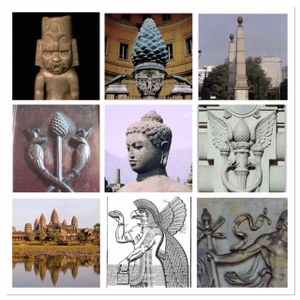You can either see yourself as a body that has a soul OR as a soul that has a body to use. It has been a dilemma and a big question for all alchemists, philosophers and religious scholars as to where the seat of the soul in our bodies is. Since Ancient times we have heard about a bone in the human body that never decomposes no matter how long a body is deceased. It contains the DNA of a man or woman that can be activated at any time and like a magical resurrection, the Creator of the Cosmos can create an entire new body with only this bone. Through my studies I discovered that this very special bone in our bodies is called the Luz bone. Luz means a “nut bearing tree” or the almond tree. The almond tree is very special as it is the first tree to awaken from its winter sleep in the beginning of spring and it is related to the spring and awakening of the soul.
There was a place in the Old Testament where Jacob “halted and had a prophetic vision” which changed the entire history of humanity. That place was Luz and in that special place Jacob saw God face to face therefor that was the place of the “Face of God”, which in Hebrew is called “Peni-El”. From that time Jacob’s name changed to Israel and Luz became Peni-El. But how is the almond tree related? The almond tree in Hebrew is “shakeid” which translates to “to watch” or “to awaken”. It is therefore God’s watchfulness and immediately it comes to mind that we are talking about a God who observes through His eye, God’s eye. Where in the body can a man like Jacob see God face to face, or more specifically, eye to eye? The Luz bone is the sphenoid bone or the “winged bone” which with its two “wings” is protecting what is seated inside on the “saddle” of the bone. This protected part is called the pineal gland or “the third eye”, which is cone shaped like an almond fruit.
God has two extreme characters: the most kind and the most just. With the balance of these two extreme characters the cone shaped fruit of the almond tree will develop into the tree of life. Love is the force that nurtures this fruit and helps it to grow through different phases of life so that it can reach its full potential. It is the movement and flow of the deepest chakras towards the highest chakra. In order to have the kingdom of heaven on Earth we need to find the balance of the just quality of God and the merciful aspect of God. In Ancient Persia and Sumer they knew that each of us need to find that balance by awakening our pineal gland or third eye and in so doing give opportunity to the fruit of our tree of life to become the flower and then the tree of life, thus getting to the highest level of heaven whilst our roots are still here on Earth. The Hebrew Ark of Covenant and the Ark of Laws that was protected by winged angels or cherubim was built in order to find that heavenly balance on Earth.
The Persian carpet as a tool for mysticism and Sufism was designed in such a way that it reminds us of the journey of our soul on Earth and what is needed to be done to experience heaven whilst we are experiencing life on Earth. If you remember, on the carpets of the body – Part 2, we were talking about the lower frequency colours that correlates with the lower chakras in our bodies, ie. the root chakra and the tones of red. In the next article when we discuss the mind and Persian carpets we will see the colours of the high frequencies like green, blue and indigo, which correlate with the higher chakras in our bodies. What is amazing is that on the carpets that relate to the soul the balance colour which has a medium frequency, yellow, is more dominant and the background is often white and black. It gives credence to the theory that the path of the soul is the balance of the higher and lower frequencies and from the frequency of yellow (which is also related to the solar plexus chakra and the Sun God/dess, like Mithra) you find a gateway to come out of the world of frequency and vibration and rest in an “all colour or no colour zone (ie. Black and white)”. Majority of the Persian carpets that focus on the soul have a one directional pattern that is related to the niche or mihrab design whilst the others have a repeating design. The niche/mihrab design usually has a resemblance to a vase or tree of life with two protecting winged angels or cherubim on either side.
In Part 4 we will discuss carpet with focus on mind.



